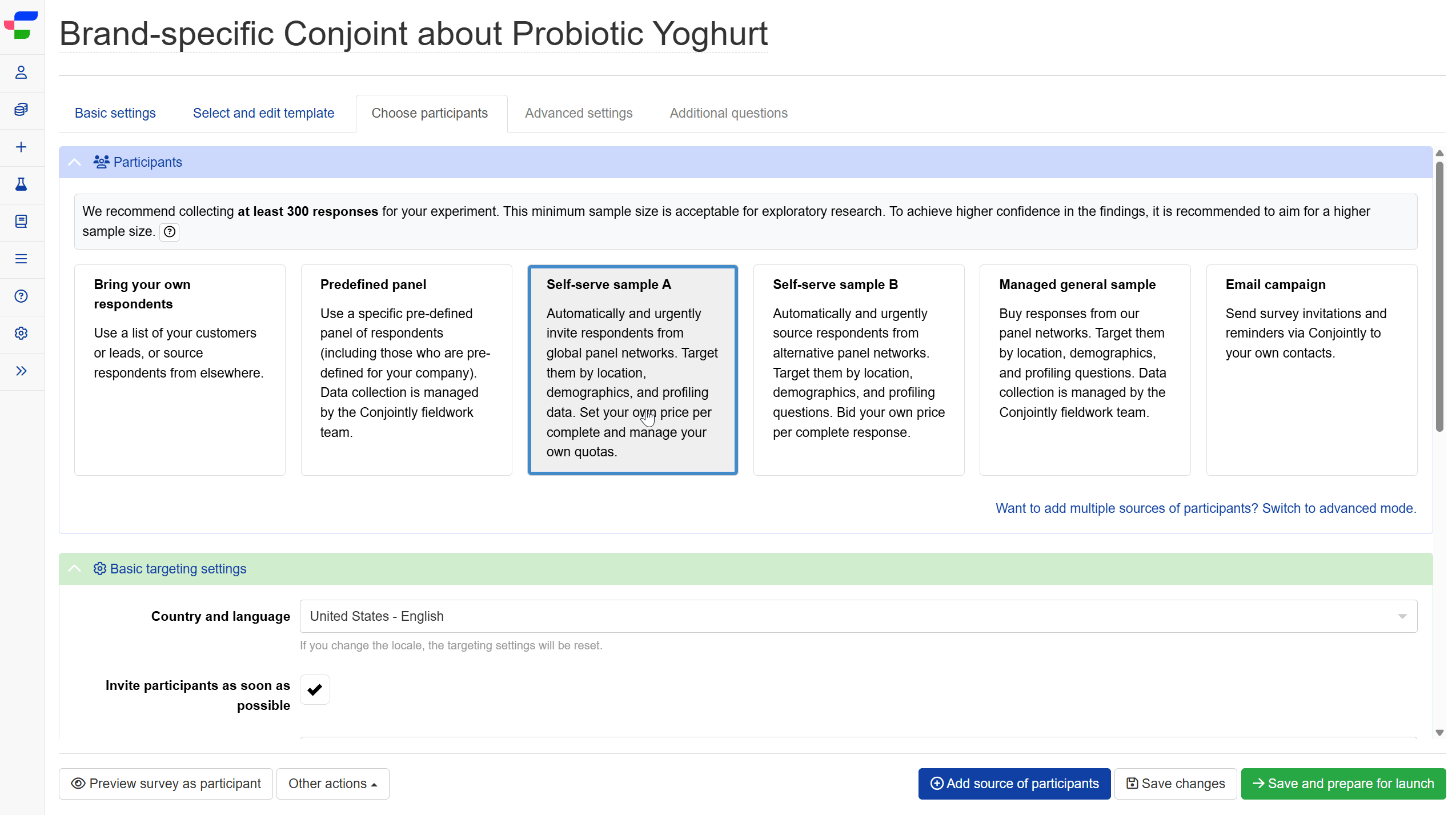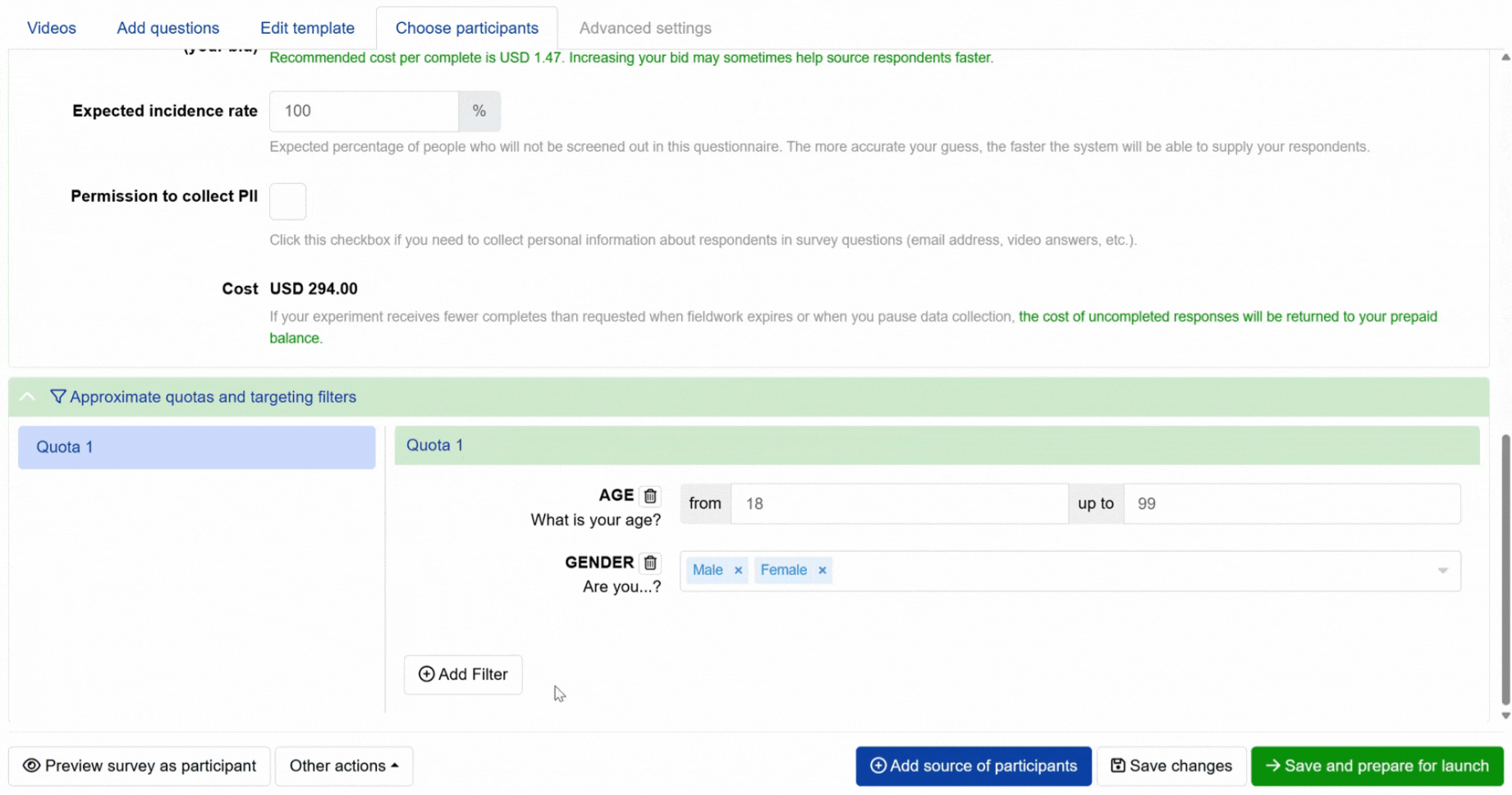Getting started with Self-serve sample
Use Self-serve sample if you would like to automatically and urgently invite respondents from global panel networks. You can target respondents by country, region, age, gender, and deep profiling characteristics. The Self-serve sample options allow you to set your own price per complete and manage your own quotas.
For collecting data over time for time series research, you can easily duplicate Self-serve sample sources to maintain consistent sample definitions, and schedule data collection in advance.
How to take control of your respondent sourcing
Watch our demo video to learn how to manage settings and optimise respondent sourcing with Self-serve sample.
Choose your Self-serve sample source
Conjointly offers two Self-serve sample options: A and B. Both are sourced from different sets of panels and offer a wide range of targeting filters, but available filters may differ between options.

If you can’t find a specific targeting option in one source, try the other. However, please note that you cannot combine filters or quotas from A and B into a single sample source, as they are from different sample providers.
You can also include both Self-serve sample A and B in a single experiment via the advanced mode. This approach allows you to include multiple instances of Self-serve Sample A and B, predefined panels, and more.
Configure basic targeting settings
- Select the country and language of your desired respondents.
- For Self-serve sample A, select if you wish to invite participants as soon as possible. Alternatively, you can specify the desired dates of fieldwork, within a 30-day window.
- Specify the number of responses needed.
- Enter your estimated cost per complete response. The system will recommend a new cost if your initial bid is found to be infeasible.
- Enter the expected incidence rate, or the expected percentage of people who will not be screened out of the survey. The button appears when screen out questions, Video Responses, or device specifications are included in the experiment, allowing you to adjust the incidence rate to a more accurate estimate.
- Check the permission to collect PII checkbox if personal respondent information is required. This is required for surveys that contain video responses or collect email addresses.
Please note that all settings above are available for both Self-serve sample A and B, except for the fieldwork date option, which is only available for Self-serve sample A as described. For Self-serve sample B, participants are always invited as soon as possible.

Set approximate quotas and targeting filters
You can configure multiple quotas to achieve desired sample proportions within your survey respondents. Within each quota, you can apply filters to reach your target profiles.
Quotas and their filters can be renamed or edited as needed. To add a new quota, duplicate the first one and customise it accordingly. Please note that quotas must have distinct filters from one another.

To add filers:
- Click the button.
- On the pop-up, select your filtering question from the Category tab or All tab. You may also use the organised categories or search bar to quickly find specific questions.
- Select your desired answers for the selected question.
You may add up to five filters in each quota.

The system will recalculate and display the updated cost estimate as you update the settings. It will also evaluate the feasibility of the parameters set.
Feasibility check results
Feasible and ready to launch
The targeted number of responses and cost per complete are feasible based on the parameters set. You may optionally increase your bid to expedite data collection.

Cost per complete is too low
If the feasibility check shows the number of responses is achievable but the set cost per complete is too low, you can click the button to automatically increase your bid to the minimum recommended cost per complete.

Quota sample sizes exceed total number of responses
When your quota sample sizes exceed the total number of responses, you can increase the total number of responses via or by adjusting the quotas. You can then adjust the cost per complete accordingly to proceed.

Insufficient feasibility
If the total number of responses you specified exceeds what the system expects is feasible, you will need to reduce the target number of respondents. This may require adjusting quota sample sizes downward as well.

Unable to determine feasibility
In rare cases where the system cannot retrieve cost data for your desired responses, you can switch to Conjointly’s fully-managed Predefined panels. Either select from Predefined panels in your account or contact us to build a custom panel tailored to your needs.
How performant is Self-serve sample?
The performance of Self-serve sample varies depending on your targeting criteria, bid, country, and other factors. It also varies over time:
- For example, often a lower bid is sufficient to get responses during certain times of the week (like Mondays, Tuesdays, and Wednesdays) compared to others (like Thursdays, Fridays, and weekends) because most researchers tend to launch surveys towards the end of the week.
- The popularity of specific panel apps and websites ebbs and flows over time, affecting how quickly respondents can be recruited from them.
Based on data from January 2024 till early December 2025, we find that both Self-serve sample A and B perform similarly on most metrics but there is a lot of variability across individual launches. Below are some key performance metrics for both Self-serve sample options:
| Metric | Self-serve sample A | Self-serve sample B |
|---|---|---|
| Successful launches (i.e. percentage of lauches with target N>10 where we delivered >10) | 84% | 86% |
| Launch delay (minutes from survey launch to first entry): 20th percentile | 0.8 minutes | 0.5 minutes |
| Launch delay (minutes from survey launch to first entry): median | 1.5 minutes | 0.8 minutes |
| Launch delay (minutes from survey launch to first entry): 80th percentile | 5.4 minutes | 2.1 minutes |
| Speed of data collection: 20th percentile | 3 completes per hour | 5 completes per hour |
| Speed of data collection: median | 74 completes per hour | 44 completes per hour |
| Speed of data collection: 80th percentile | 432 completes per hour | 248 completes per hour |
| Delivery vs. the target sample size by the end of the project: 20th percentile | 30% | 27% |
| Delivery vs. the target sample size by the end of the project: median | 101% | 109% |
| Delivery vs. the target sample size by the end of the project: 80th percentile | 121% (mostly on small target N) | 134% (mostly on small target N) |
What to do if data collection is stalling?
There are four most common reasons why not enough respondents are coming into your survey:
- It’s still too early. Sometimes responses will come in not immediately, but within an hour or so. If it’s nighttime in the country where you are collecting responses, they will tend to come in slower.
- Your bid is not sufficient and needs to be increased to attract more people.
- Your quotas and targeting filters are too narrow (i.e. panels do not have enough people who have been profiled on your selected filters).
- Your screening questions are too strict, resulting in overly high drop-off rates.
If you’ve waited for a couple of hours and see too few responses coming in or completing your survey, we recommend that you re-launch data collection with a higher bid or with different targeting options.
To do so, try these steps:
- Pause data collection on the current source. This action will return unused money into your balance.
- Make a copy of the self-serve sample source within the same experiment.
- Modify it:
- Put a slightly higher bid, or
- Put different targeting criteria, or
- Edit your screening questions, or
- Switch from Self-serve sample A to B (or vice versa).
- Relaunch. Make sure to use your prepaid balance when you do that (by ticking the box “Use prepayment balance and bonus credits” on check-out).
If that does not work, please send your panel request. We should be able to assist you with a managed sample solution.
You can also read more about how to monitor and maintain data quality when using Conjointly’s Self-serve sample options.